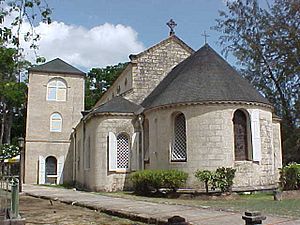Sir Philip Gibbes, 1st Baronet facts for kids
Sir Philip Gibbes, 1st Baronet (1731–1815) was an important figure and estate owner in Barbados. He was also known as Gibbs.
A Life of Influence: Sir Philip Gibbes
Early Life and Education
Philip Gibbes was born in St James' Parish, Barbados, on March 7, 1731. His family had a long history on the island, with his ancestors settling there as early as 1648. His parents were Philip Gibbes and Elizabeth Harris.
As a young man, Philip traveled to London, England, to study law at the Middle Temple. This was a famous place where many lawyers were trained. After his studies, he returned to the West Indies to manage his family's sugar estates.
A Baronet and Public Servant
Sir Philip Gibbes became a respected member of the Barbados government, known as the legislature. He advised the island's governor in Bridgetown on legal matters. Even though he spent time in Barbados, he also lived in Great Britain for periods, which meant he was sometimes an "absentee owner" of his estates.
On May 30, 1774, King George III created the Gibbes baronetcy, making Philip Gibbes the first Baronet. A baronet is a special title of honor, passed down through families, similar to a knight but hereditary.
Diplomatic Efforts During a Time of Change
Sir Philip Gibbes played a unique role during the American Revolutionary War. He met with Benjamin Franklin in Paris several times between 1777 and 1778. Barbados was in a difficult position during this war, and Gibbes acted as a "self-appointed mediator," trying to help find solutions.
He also represented the interests of Caribbean estate owners to the British Prime Minister, Lord North. This shows how important he was in speaking for the people of the West Indies during a time of big changes.
Community Involvement and Unique Tokens
In 1777, Sir Philip joined the Society for the Propagation of the Gospel in Foreign Parts, a group focused on religious and educational work. During a period of civil unrest in London called the Gordon Riots in 1780, he supported the idea of forming a local volunteer group to help keep peace in Marylebone.
Sir Philip Gibbes is also remembered for something quite interesting: special token coins. From 1788, these tokens, designed by John Milton, were used in Barbados. They were not official money but were widely accepted, especially his "Neptune" tokens.
Later Years and Legacy
In his later years, Sir Philip Gibbes lived in London. His health declined, and he lost his eyesight. He passed away on June 27, 1815, at Springhead House and was buried at St James Church, Barbados.
Writings and Ideas
Sir Philip Gibbes was a member of the Barbadian Society for the Improvement of Plantership, a group dedicated to improving farming methods.
Sharing Knowledge on Estate Management
Sir Philip wrote several works, sharing his knowledge and ideas. These included:
- Instructions for the Management of a Plantation in Barbadoes and for the Treatment of Negroes (1786): This book offered advice on how to manage large estates and the people who worked on them.
- Instructions for the Treatment of Negroes (1786, with a second edition in 1797): This publication discussed ways to manage the workforce on estates.
- Letter to John Beckles, Esq., Attorney General at Barbadoes, and Correspondence between them on the subject of the Conveyance of the Kendal Plantation being Unfairly obtained (1802): This letter and related papers discussed a disagreement over the ownership of an estate.
Views on Trade and Economy
He is also believed to have written Reflections on the proclamation of the second of July 1783. This work discussed trade between the newly formed United States of America and the West India islands, offering ideas to the British Prime Minister, William Pitt the Younger.
Family Life and Connections
Marriage and Raising a Family
In 1753, Sir Philip Gibbes married Agnes Osborne at St James Church in Barbados. Agnes was the only child of Samuel Osborne, another estate owner from Barbados. Her family had also settled on the island in 1634. Agnes passed away in London in 1813, before her husband.
Sir Philip and Lady Gibbes had four children, all born in Barbados. Lady Gibbes mostly raised their children in England, while Sir Philip focused on his business and political work in Barbados, London, and Bristol. In the 1780s, Lady Gibbes and her daughters lived near Wolverhampton in England. They even had a visit from the famous preacher John Wesley in 1783. The children's governess, Mary Freeman, was a well-known correspondent of Wesley.
Children and Their Paths
Their eldest son, Philip, studied at Cambridge University and became a judge in Barbados. He served as the Chief Justice of Barbados but faced a disagreement with Governor George Poyntz Ricketts in 1797 over a court case, which led to his removal from the position. He married Maria Knipe in 1807 and passed away in 1812.
Their other children were:
- Samuel Osborne: He was also an estate owner and held an important financial role in Grenada. He passed away in 1807 and was the father of Samuel Osborne Gibbes, 2nd Baronet.
- Elizabeth: She married Charles Abbot, 1st Baron Colchester in 1797.
- Agnes: She remained unmarried.
Notable Family Ties
Later in his life, Sir Philip had some disagreements with his two sons. Through his daughter Elizabeth's marriage, the Gibbes family became connected to the family of the famous philosopher Jeremy Bentham. Elizabeth's husband's mother later married Jeremy Bentham's father.


